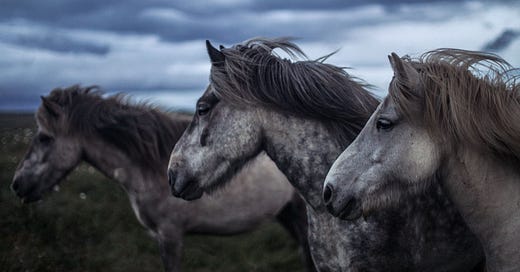Military history and tactics is one of those things that get used for inspiration in all sorts of science fiction and fantasy contexts. Naomi Novik & Anne McCaffrey pretty obviously used horses and planes as inspiration for dragons in their works, and Age of Sail battles are the blueprint for a great many Space Operas. But I wanted to learn more about cavalry tactics to see if I could come up with a new fantasy twist. Here's what I learned.
Quick Facts
Horses were used to draw chariots as part of warfare from the Early Bronze Age (c. 1800 BC onwards). However, the idea of individuals riding on horseback into battle did not become widespread until the Iron Age (c. 1000 BCE onwards) after Iranian and other nomadic people from Asia imported the concept into the Middle East.
While horses are typically associated with ‘cavalry’ charges through history, other animals have also been used. Elephants were widely used in India and other regions. The Carthaginian general Hannibal famously marched over the Alps with elephants from Africa to attack Rome during the Second Punic War (218 BC – 201 BC).
The Huns were one of the world’s first great cavalry empires. Under their leader Attila these Asiatic warriors ruled a huge empire spanning from Germany to the Black Sea in the fifth century and held the Roman Empire to ransom.
The Spanish actually contributed relatively few troops to the conquest of the Aztec Empire between 1519 and 1521. However, they had heavy cavalry, which the people of Central America were terrified of and charges of which caused them to flee in battle against a numerically inferior enemy.
As late as the time of the American Civil War (1861–1865) cavalry charges were still being used to devastating effect. The Battle of Brandy Station on the 9th of June 1863 in Virginia involved over 20,000 cavalry in total and ended in a Union victory.
Circling Pickoffs
While the Roman war machine is synonymous with its infantry, the Roman legions were augmented by cavalry divisions such as Illyrian cavalry and the cataphracts of the late empire. However, generally speaking the Romans suffered more from their enemies’ use of cavalry. In particular the Parthians of Mesopotamia, and the Palmyrenes of the deserts east of Roman Judaea and Syria under Queen Zenobia in the third century, relied heavily on mounted soldiers. In 53 BC the Parthians inflicted one of the heaviest defeats ever against the Romans at the Battle of Carrhae, using their cavalry to continuously circle the Roman legions and pick off tens of thousands of men over the space of two days in hit and run attacks.
Smol Horses
The elite fighting force of the High Middle Ages (1000–1300) in Europe were the Normans who rode into battle as armoured knights on horseback. This form of heavy cavalry vastly expanded Christian Europe, conquering the north and east of the continent and Christianising the Pagans there, while also undertaking religious crusades to the Holy Land and southern Spain. However, what is relatively unknown is just how small the Normans’ horses were. Far from being huge stallions of 17 or 18 hands, such as we would consider big today, the average Norman horse was only 14 hands or less. These were effectively ponies. Still they struck fear into their enemies when charging against them on the field of battle.
Wide Ranging
The greatest cavalry empire ever known was that of the Mongols. Under the leadership of Genghis Khan (c. 1162–1227) these nomadic, horse-riding people of Mongolia and the Asian Steppe began conquering a vast array of land which would eventually stretch from Ukraine in Europe all the way to Korea and China. It was the largest contiguous empire in human history and largely based on the Mongols’ ability to ride vast distances on horseback and strike at their enemies with their recurved composite bows while riding.
Modern Machines
Cavalry were only finally displaced from the battlefield with the invention of the machine-gun in mid-nineteenth century. With the advent of this weapon cavalry charges could be brutally stopped by machine-gun barrages. As such, nearly all of the main powers stopped using cavalry divisions during the First World War. They were very quickly replaced though by the invention and use of the first tanks on the Western Front in France in 1916. Indeed, in recognition of the fact that tanks replaced cavalry in the ranks of modern armies, tank divisions quickly became known as ‘armoured cavalry’.
📗 If you found this interesting, you might also enjoy the Horseboat edition, or this ~6 minute read summarizing scholarly debates about horse domestication.
💚 If you learned something from this overview, consider forwarding it to a friend and encouraging them to sign up for more overviews of my research into obscure history and science.
🐎 Do you have a favorite story (real or otherwise) involving unique cavalry tactics? Please reach out — I'd love to hear about it, either via email or in a comment where other readers can see.



